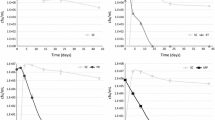Abstract
Two Saccharomyces cerevisiae strains, one specifically of S. cerevisiae and another belonging to the physiological race S. uvarum, exhibited associative and dissociate thermal profiles, respectively. The S. cerevisiae subsp. uvarum strain, which displayed the dissociative profile, was characterized by a higher aptitude for fermenting glucose in a superoptimal temperature range as well as by a lower fatty acid unsaturation degree. On the other hand, both strains exhibited a similar fatty acid composition modulation pattern with regard to temperature: the unsaturation level presented two relative maxima at 15 and 40° C. However, on the basis of Central Composite Design results, supplementation with an oleic acid source under semi-anaerobic conditions did not improve the fermentative performances in either strain. the modelling of fermentation rate in relation to certain variables indicated that the fermentative performance at superoptimal temperatures, and particularly the optimal temperature (T opt) and maximal temperature (T max) of the strain displaying a dissociative profile, could be increased by acting on medium composition.
Similar content being viewed by others
References
Augustyn OPH (1989) Differentiation between yeast species, and strains within species, by cellular fatty acid analysis. 2. Saccharomyces cerevisiae. S Afr Enol Vitic 10:8–15
Beavan MJ, Charpentier C, Rose AH (1982) Production and tolerance of ethanol in relation to phospholipid fatty acyl composition of Saccharomyces cerevisiae NCYC 431. J Gen Microbiol 128:1445–1447
Box GEP, Hunter WG, Hunter JS (1978) Statistics for experimenters. An introduction to design data analysis and models building. Wiley, New York
Calderbank J, Keenan MHJ, Rose AH, Holman GD (1984) Accumulation of amino acids by Saccharomyces cerevisiae Y185 with phospholipids enriched in different fatty acyl residues: a statistical analysis of data. J Gen Microbiol 130:2817–2820
Coolbear KP, Berde CB, Keough KMW (1983) Gel to liquid-crystalline PHASE transition of aqueous dispersion of polyunsaturated mixed-acid phosphatidylcholines. Biochemistry 22:1466–1473
Davis PJ, Fleming BD, Coolbear KP, Keough KMW (1981) Gel to liquid-crystalline transition temperatures of water dispersion of two pairs of positional isomers of unsaturated mixed-acid phosphatidylcholines. Biochemistry 20:3633–3636
Fantin DJ, Tustanoff ER (1981) Effect of amphotericin B, deuterium oxide and heat on yeast mitochondial bioenergetics and on survival of yeast with altered sterol membranes. In: Stewart GG, Russell I (eds) Current developments in yeast research, vol. 4. Advances in biotechnology. Pergamon Press, Toronto, pp 185–201
Guerzoni ME, Gardini F, Sinigaglia M (1989) Modulation of lipid composition of yeasts in stress conditions. Yeast 5:S415-S419
Guerzoni ME, Gardini F, Duan J (1990) Interactions between inhibition factors on microbial stability of fruit-based systems. Int J Food Microbiol 10:1–18
Hacking AJ, Taylor IWF, Hanas CM (1984) Selection of yeast able to produce ethanol from glucose at 40° C. Appl Microbiol Biotechnol 19:361–363
Hilge-Rotmann B, Rehm HJ (1991) Relationship between fermentation capability and fatty acid composition of free and immobilized Saccharomyces cerevisiae. Appl Microbiol Biotechnol 34:502–508
Holman RT (1978) Quantitative chemical taxonomy based upon composition of lipids. Prog Chem Fats Other Lipids 16:9–29
Kock JLF, Botes PJ, Erasmus SC, Lategan PM (1985) A rapid method to differentiate between four species of the Endomycetaceae. J Gen Microbiol 131:3393–3396
Lands WEM, Graff G (1981) Effects of fatty acid structure on yeast cell physiology. In: Stewart GG, Russell I (eds) Current developments in yeast research, vol 4. Advances in biotechnology. Pergamon Press, Toronto, pp 331–343
Mishra P, Kaur S (1991) Lipids as modulator of ethanol tolerance in yeast. Appl Microbiol Biotechnol 34:697–702
Pilkington BJ, Rose AH (1991) Incorporation of unsaturated fatty acids by Saccharomyces cerevisiae: conservation of fatty acyl saturation in phosphatidylinositol. Yeast 7:489–494
Ratkowsky DA, Lowry RK, McMeekin TA, Stokes AN, Chandler RE (1983) Model for bacterial culture growth rate throughout the entire biokinetic temperature range. J Bacteriol 154:1222–1226
Ratledge C (1982) Microbial oil and fats: an assessment of their commercial potential. Prog Ind Microbiol 16:125–206
Rattray JBM (1988) Yeasts. In: Ratledge C, Wilkinson SG (eds) Microbial lipids. Academic Press, New York, pp 555–698
Sherman F (1959) The effects of elevated temperatures on yeast. 1. Nutrient requirements for growth at elevated temperatures. J Cell Comp Physiol 54:29–35
Sinigaglia M, Guerzoni ME, Gardini F, antonelli A (1991) Interaction between cell lipid composition, glutamate and l-leucine transport and fermentation performance in different Saccharomyces cerevisiae strains. Ann Microbiol 41:27–39
Spencer-Martins I, Uden N van (1982) The temperature profile of growth, death and yield of the starch-converting yeast Lipomyces kanonenkoae. Z Allg Mikrobiol 22:503–505
Starr PR, Parks LW (1962) some factors affecting sterol formation in Saccharomyces cerevisiae. J Bacteriol 82:1042–1046
Uden N van (1984) Temperature profiles of yeasts. Adv Microb Physiol 25:195–251
Uden N van, Cruz Duarte H da (1981) Effects of ethanol on the temperature profile of Saccharomyces cerevisiae. Z Allg Mikrobiol 21:743–750
Uden N van, Madeiro Lopes A (1970) Concurrent exponential growth and death of cell populations of Saccharomyces cerevisiae at superoptimal growth temperatures. Z Allg Mikrobiol 10:515–526
Walton EF, Pringle JR (1980) Effect of growth temperature upon sensitivity in Saccharomyces cerevisiae. Arch Microbiol 124:285–287
Watson K (1984) Membrane lipid adaptation in yeast. In: Kates M, Manson LA (eds) Membrane fluidity, biomembranes,vol. 12. Plenum, New York, pp 517–542
Watson K (1987) Temperature relations. In: Rose AH, Harrison JS (eds) The yeasts. Academic Press, London, pp 41–71
Zwietering MH, Jongenberger I, Rombouts FM, Riet K van't (1990) Modeling of the bacterial growth curve. Appl Environ Microbiol 56:1875–1881
Author information
Authors and Affiliations
Additional information
Correspondence to: M. E. Guerzoni
Rights and permissions
About this article
Cite this article
Sinigaglia, M., Gardini, F. & Guerzoni, M.E. Relationship between thermal behaviour, fermentation performance and fatty acid composition in two strains of Saccharomyces cerevisiae . Appl Microbiol Biotechnol 39, 593–598 (1993). https://doi.org/10.1007/BF00205058
Received:
Accepted:
Issue Date:
DOI: https://doi.org/10.1007/BF00205058




